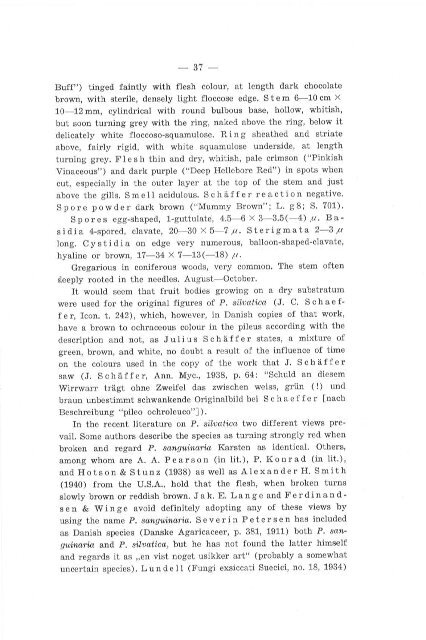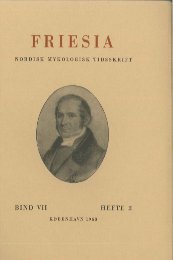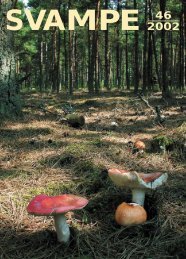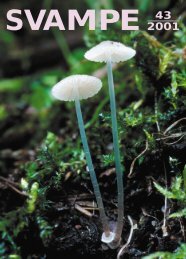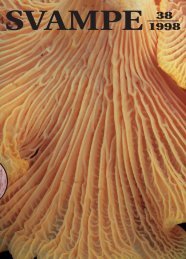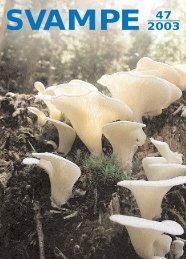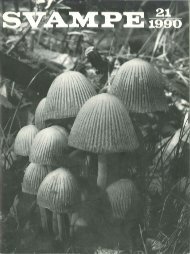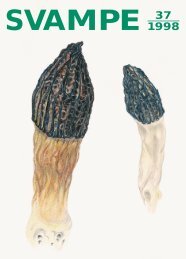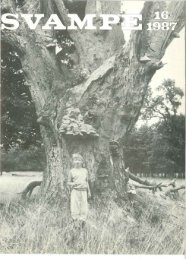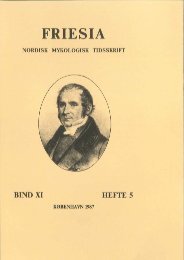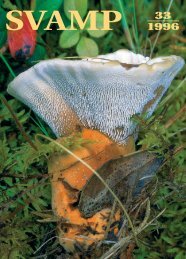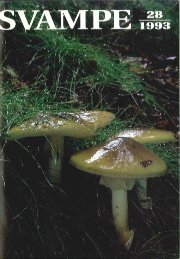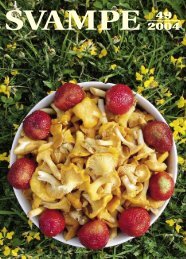Create successful ePaper yourself
Turn your PDF publications into a flip-book with our unique Google optimized e-Paper software.
- 37 -<br />
Buff") tinged faintly with flesh colour, at length dark chocolate<br />
brown, with sterile, densely light floccose edge. S t e m 6-10 cm X<br />
10-12 mm, cylindrical with round bulbous base, hollow, whitish,<br />
but soon turning grey with the ring, naked above the ring, below it<br />
delicately white floccoso-squamulose. R i n g sheathed and striate<br />
above, f airly rigid, with white squamulose underside, at length<br />
turning grey. F l e s h thin and dry, whitish, paIe crimson ("Pinkish<br />
Vinaceous") and dark purpie ("Deep Hellebore Red") in spots when<br />
cut, especiaIly in the outer layer at the top of the stem and just<br />
above the gills. S m e Il acidulous. S c h a f f e r r e a c t i o n negative.<br />
Spore powder dark brown ("Mummy Brown" ; L. g8; S. 701) .<br />
S P o r e s egg-shaped, l-guttulate, 4.5-6 X 3- 3.5 (- 4) p. B as<br />
i d i a 4-spored, clavate, 20-30 X 5-7 p . S t e r i g m a t a 2-3 p<br />
long. C y s t i d i a on edge very numerous, balloon-shaped-clavate,<br />
hyaline or brown, 17-34 X 7-13(-18) p.<br />
Gregarious in coniferous woods, very common. The stem often<br />
deeply rooted in the needles. August-October.<br />
It would seem that fruit bodies growing on a dry substratum<br />
were used for the original figures of P. silvatica (J. C. S c h a e ff<br />
e r , lcon. t. 242), which, however, in Danish copies of that work,<br />
have a brown to ochraceous colour in the pil eus according with the<br />
description and not, as J u l i u s S c h a f f e r states, a mixture of<br />
green, brown, and white, no doubt aresult of the influence of time<br />
on the colours used in the copy of the work that J. S c h a f f e r<br />
saw (J. S c h a f f e r, Ann. Myc. , 1938, p. 64: "Schuld an diesem<br />
Wirrwarr tragt ohne Zweifel das zwischen weiss, grtin (!) und<br />
braun unbestimmt schwankende Originalbild bei S c h a e f f e r [nach<br />
Beschreibung "pileo ochroleuco"]).<br />
In the recent literature on P. silvatica two different views prevail.<br />
Some authors describe the species as turning strongly red when<br />
broken and regard P. sanguinaria Karsten as identical. Others,<br />
among whom are A. A. Pearson (in lit.), P. Konrad (in lit.),<br />
and Hots on & Stunz (1 938) as well as Alexander H. Smith<br />
(1940) from the U.S.A., hold that the flesh, when broken turns<br />
slowly brown or reddish brown. J a k. E. L a n g e and F e r d i n a n d <br />
s e n & W i n g e avoid definitely adopting any of these views by<br />
using the name P. sanguinaria. S e v e r i n P e t e r se n has included<br />
as Danish species (Danske Agaricaceer, p. 381, 1911) both P. sanguinaria<br />
and P. sitvatico; but he has not found the latter himself<br />
and regards it as "en vist noget usikker art" (probably a somewhat<br />
uncertain species). L u n d e Il (Fungi exsiccati Suecici, no. 18, 1934)


